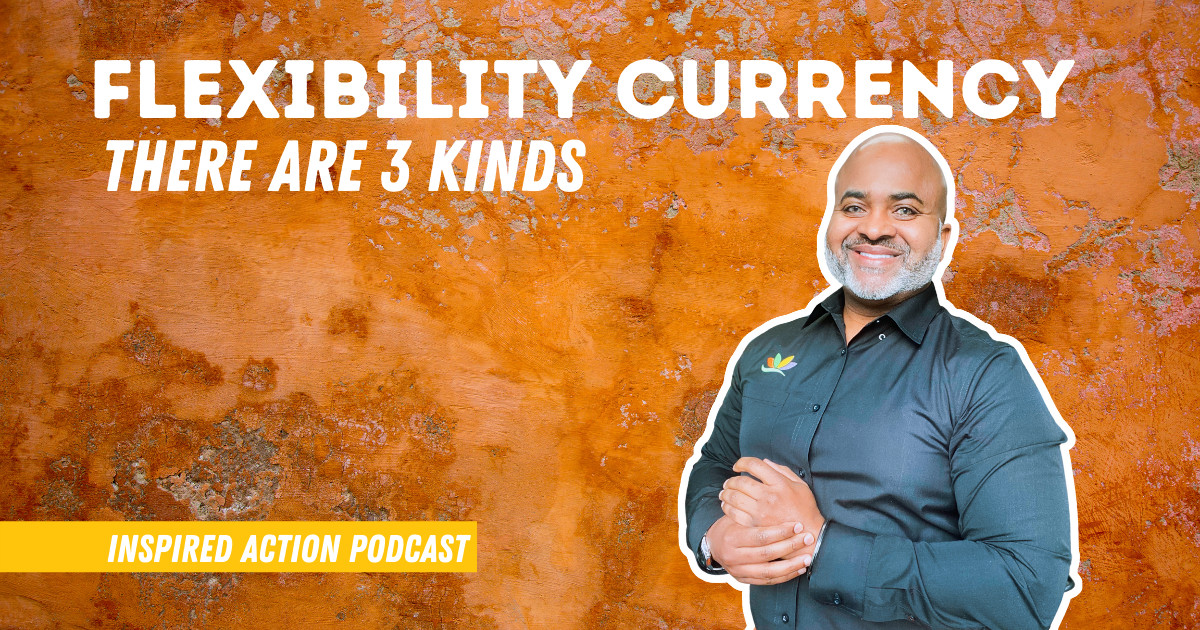“Flexibility Currency – There Are 3 Kinds” Brief Summary:
“I really think when we talk flexibility, people are only thinking in terms of their time, but there’s so much more to it than that.”
Do you have flexibility currency? Did you know that there’s more to flexibility currency and being flexible, than just time? In this Inspired Action for Imperfect Humans podcast episode, Christopher Lawrence and Kyle Kalloo discuss the three different types of flexibility currency, and why flexibility currency is very important for both the employee and leaders in any organization!
Summary:
- Introduction
- What is flexibility?
- What is flexibility currency?
- Kyle tells his story with a past leader, and being flexible.
- Taking action on being flexible.
Calls to Action:
Even before the remote workforce evolution, office culture was inherently fragile. After all, it’s made up of imperfect humans interacting with other imperfect humans. And while perfection isn’t the goal, we all secretly wish for a workplace where people find ways to bring out the best in each other. Unfortunately, that’s not always an intuitive skill. It takes guidance, practice, and then more guidance and practice… but with the right leadership, it’s definitely achievable. How do you enhance your workforce’s ability to engage, collaborate, and adapt in this volatile and uncertain reality? Get the answers to your culture questions when you setup a complimentary Discovery Session with Kyle Kalloo at https://ChangeMyLifeCoaching.as.me/?appointmentType=14623413
Not loving your career? Feel you need a change in your job? Let’s Strategize! Book a complimentary Strategy Session with Christopher Lawrence here: https://ChangeMyLifeCoaching.as.me/?appointmentType=14044176
Tell us your “inspired stories” stories by visiting www.InspiredActionPodcast.ca
Christopher Lawrence LinkedIn: https://www.linkedin.com/in/career-life-coach-christopher-lawrence/
Kyle Kalloo LinkedIn: https://www.linkedin.com/in/kyle-kalloo/
Change My Life Coaching & Change My Business Coaching LinkedIn: https://www.linkedin.com/company/6446498/admin/
Looking to create a corporate coaching culture? Reach out to Kyle Kalloo: [email protected]
Website: https://strategicleader.ca
“Flexibility Currency – There Are 3 Kinds” Transcript:
[00:00:00] This is really important Kyle because I, I really think when we talk flexibility, people are only thinking in terms of their time, but there’s so much more to it than that. The thought of being imperfect, keeping you from taking action. Welcome to inspired action for imperfect humans. Each week, we give you real life stories and thought provoking research that inspires your soul to live a more fulfilled life through your own actions.
From the heart of Calgary Canada. Here are your hosts. Award winning coaches, Christopher Lawrence, and Kyle Kalloo. Well, hello, everyone. Welcome to another exciting week of inspired, inspired actions for imperfect humans. One day, I swear Christopher I will get that right. Trust me. When I say I will get the right now, he’s looking at me with his judgemental face, shaking his head side to side as he does.
And he does it very well. Actually I probably too well, in fact, before we get to. Before we get [00:01:00] started
because you, you say, trust me, girl, there’s so many reasons why I cannot trust you. You have issues, or we get started folks. We’ve been asking, we’re getting so close to our download total. Um, so I know if you, the best way you can support our podcast is if. Subscribe, we’re getting close. I’m not saying that.
It’s there, but another 7,000 or something we’re getting there folks. And I, I believe that you can help us get there. So like, and subscribe, share a podcasts. If you heard something that really resonated with you, I am sure someone else out there it will resonate with as well, because you never know who needs to hear the message.
That’s all I’m saying. So share like, and subscribe, because this allows us to get this information going and then Christopher gets a real sense of purpose that what he says really matters. Okay. Um, cause [00:02:00] what I like about what we do this, what I like about this podcast is just our ability to be flexible.
Right? Because look at the topic and someone brought this to me the other day. The range of subjects and topics and items and things that we discuss on this thing really shows flexibility. It’s not rigid where we’re like, no, we’re only going to talk about here, or we’re not trying to be masters of many either, but we really talk about what we know, what we experience, what we work with our clients on.
And you and I are ad, you know, um, readers. You know, we do listen different things. We share a predilection for ongoing knowledge and learning. And when we learn that we always want to share that. And I think that’s what I like about, you know, the flexibility of our knowledge and how we want to share and how do we get people in front of that.
So I’m hoping we can specifically talk about flexibility and flexibility specifically in the workplace. What does it actually [00:03:00] look like? You know, is there who, and again, I think. Who should be flexible. Should it be the employees? Shouldn’t be, the leaders should be a combination of both. Should it be individual?

What’s your take on flexibility in way. I think, I think flexibility is probably the right word. I think, uh, you know, there’s also this whole thing that care is the new currency and I don’t disagree with that either. I think that, I think the big thing with all of it is that there has to be an understanding that flexibility is defined differently by people.
So I’ve seen organizations do these broad sweeping breaststroke kind of policy. Um, which I understand you got to make it fair and consistent and right. Cause then you can manage it. Um, you know, to try and address something only leaving everybody dissatisfied because they piecemeal something together rather than, you know, one of the big oil and gas companies here in Calgary, probably they were way ahead of their time.
They moved to a four-day [00:04:00] work week every second week. Um, and you didn’t have to put extra hours in or whatever prior. And, um, so it was a true day off, not just adjusted hours, but they, um, the, the, uh, Like half of the people in, it were like they were, they were so ticked off because it affected their vacation outcomes that, and so it was like, it wasn’t that it was a bad thing.
It was just that there wasn’t an understanding of, of, you know, there wasn’t good change management there. It wasn’t well communicated and what people actually wanted. Wasn’t like, that was a percentage that wanted that, but not the whole organization. And so. You know, your workplace won’t be the same for everyone, but you, you need to clearly define what these things are.
And I think that we underestimate the value of looking at individual currency. Like if I have an employee whose individual currency requires me to be flexible from [00:05:00] the perspective of being more forthcoming with compliments, that’s still flexibility in. You know, for that leader. And so it’s like, you’ll get the best from that employee.
Whereas maybe the other person wants a more hybrid or work from home option. Like when we talk flexibility these days, we always think. Time. Yeah. It’s not always about time. That’s a big part of it, but it’s not always about time, right. With everything that’s going back, you know, with mandates being lifted, depending on where you are, a lot of things are going back to, you know, what w you know, I don’t know if it’s a going, if the word the right word is going back, but I think there are some people are going back to work.
Some people might have some flexible in different things. Now, Christopher, you said this a couple of times, and I’m not sure if we defined it just in the. Of this conversation, this thing about flexibility being a currency. So, and you kind of alluded to it when it said it’s not just about time. So what exactly is that when you talk about flexibility, Yeah, I think let’s see.
Or I think that there’s a couple [00:06:00] of different ways of looking at it. I think, I think there’s, you know, everyone looks at it as time, but I would look at it in a, in several different ways. So currency is what we find value in and that’s what we’re saying here. So what, it’s, what people find value in. So, so like having a degree is a form of currency, right.
And in our world, because degrees are highly valued, rightly or wrongly, right. Individually. Right. That’s right. So, so, so there’s a few things, typically when we’re talking flexibility, these days, we’re talking behavioral, flexible flexibility, like, so w so a workplace flexibility. So this would be like looking at.
Um, you know, a hybrid work environment or do we lack flexibility, right? There’s some organizations in Calgary where we are no surprise, um, that that are saying no, everyone is back to work on March 1st, no hybrid work environment, period. You’re all back in the office. Uh, no masks, no whatever. And it’s just like, I just don’t think that that’s going to go well, especially during labor shortages, [00:07:00] uh, you say you’re not going to have a hybrid.
workforce, I’m going to say good luck, because I don’t think that you’ll be able to hire people or you’re going to have to ink. It’s not a, it’s not known for being a well-paying organization, although they could be. Um, but, but I expect that that, uh, they will have to change something, especially for their office worker.
So that’s behavioral flexibility where we’re looking at the behaviors of, of people kind of where they work, how they work. Another kind of flexibility that I was kind of alluding to before is what we call, um, uh, cognitive flexibility. So it’s about our leadership and our team members thinking differently, right?
Asking ourselves, can we assess a problem in a different way? Am I in my, like, am I saying no to this thing? So on our podcast last week, we talked about this manager that you had, who said. Who said, if I say yes to you, I have to say yes to everybody. And it’s like, well, if it’s what everybody wants and, and the impact to the organization is minimal, or [00:08:00] maybe it’s even a positive impact, then why shouldn’t it be?
Yes. What if I’m the only one asking, so then why can’t I have it? So like what if nobody else wants it? So, so, so cognitive, cognitive flexibility allows us to, to kind of think more flexibility, including team members. Like, I, I think sometimes team members and I, you know, I can speak for myself with this in my history where it’s like, you kind of get on your high horse about what you believe is right, but you’re not actually looking at what’s driving an organizational direction.
So. Flexibilities the other one. And then I think this is really important call because I, I really think when we talk flexibility, people are only thinking in terms of their time, but there’s so much more to it than that. Um, and, and then the third one is emotional flexibility. So, so this is actually about developing emotional quotient, right.

And actually becoming, and this is, this is not. This is not garbage science here. There was a meta analysis done on thousands and thousands [00:09:00] and thousands of studies about emotion and emotional intelligence and this and that. Um, both in corporations, outside of corporations, we need to become more emotionally flexible or emotionally granular.
Right? So emotional granularity is when you have labels for your emotions. And you can speak to them. You can say, Hmm, this makes me feel morose or despondent, or this makes me feel elated. Right. Being able to do that. It helps us connect with other human beings. And it creates a little bit of a situation where now we’re deconstructing the hierarchy and our mind, and we’re seeing each other as humans.
When some of these leaders are like, they have to see me up here as stoic and this and that and flawless and mistake free, but actually. Um, what you ended up doing is losing trust and disconnecting from your people. So their performance is poorer when you don’t have emotional flexibility. So emotional flexibility.
And on the flip side, there are some people who are hyper [00:10:00] emotional in the workplace. I worked with a woman. It’s just like, she’s like she just said, you know, I just need to process and cry and I just need my 20 minutes and then I’m good. And I’m like, I’m sorry, that’s not appropriate in every team meeting.
That’s not appropriate. That’s selfish. That’s a codependency. So if you need to do that, I have no problem with it, but go find a phone. Right. If you need to talk, then we can talk. But if that’s your process, you cannot hijack. That’s your you’re hijacking and people emotionally, every team meeting, that’s not appropriate.
So, and I’m like Mr. Emotional. So, so, so for me to say that, so I think that it’s important for people to focus on three forms of flexibility, behavioral flexibility, which would include. Uh, time or even bonus or, or, or salary structure or whatever, cognitive flexibility and emotional flexibility. You asked me a really simple question and I went on a tangent there because clearly this is something I give a shit about.
Totally. But I think [00:11:00] a lot of people, I think, default to time, right. When someone says to be flexible for the most part, the other thing too to recognize is that there’s, there is that flow between what. Potentially happened to someone either mentally, emotionally, right. Or just based on their, their time, because sometimes that rigidness doesn’t allow for growth.
Right. You know, and you, sometimes I, I use this expression. I know sometimes you have a different, you know, uh, Reaction to feelings with it. But I use it quite often with my families and friends and stuff like that. When it comes to break bread, you know, there was a day that we that’s how we cut bread. We broke bread.
You know what I mean? And, uh, somewhere along the line, someone came and said, do you know, you could slice this and you can get like more slices from this bread and dah, dah, dah. And I could see back in that time, some people were resistant. Some people weren’t as flexible with that. Cause they’re just like, why are you going to change it?
We’ve been breaking bread all day. Like why now you have to introduce something new. And we see that in relationships. We see [00:12:00] that in relationships, intimate relationships, relationship with colleagues, you know, your peers, your leaders, that sometimes we just want that flexibility to say, could we think about this differently?
Could we recognize that I may have a different emotional response to this? I agree with you. I think that there’s, you know, when I look at places where people might get stuck, where people might get stuck as like where there’s an organizational driver for certain reason, but, but the people in the organization aren’t aware of that.
And it seems unkind or unhuman for us to say that maybe it’s about money or it’s about the bonus for the CEO or whatever. And it wouldn’t be an appropriate thing to do necessarily because you’ll lose loyalty. But the truth is is that we all know that that’s what’s happening. And so from my perspective, it’s like, well, let’s focus on the targets.

Let’s focus on the targets and like make sure that the whole organization looks good. So I think leadership in order to have flexibility, they actually need. Like amongst their teams, they [00:13:00]actually need to be having more honest conversations and transparency where, where it’s not going to lead to something that’s litigious or, or liable.
Right. And, and I think that’s a big part of it because then we can start thinking flexibly. Around, uh, around what’s actually driving this, right? So it’s like, if this is the driver, if it’s a bottom line driver, then that’s the conversation we should have on the flip side, I think that employees can do a better job of recognizing.
Your bias is not your truth. And so it’s like start asking yourself the question, what might be driving this? Like, like if John, the leader is so rigid and blah, blah, blah, have you asked John the leader? You know, it’s like this, this seems like it’s a very fixed way of thinking. And it sounds important to you help me understand why there’s no flexibility in this, right.
Or help me under. What we can do to make this flexible or what’s at risk, if we are flexible. [00:14:00] Right. And I remember sort of cut you off there because I just remember a story. No, you’re not sorry. I know you’re not sorry. We do well sharing these stories. I remember when I was working with another senior leader and he was very clear that he wanted certain things happened and now I knew that it couldn’t happen.
I just knew that it, it actually is something that we just can’t do. I know the T. You felt about this particular initiative. And I just know, like, this is just going against what we do, but you know what, there were adamant about it. And I said, you know what, let me just be flexible. Let me find a way to make it work.
Right. Not my plan a, but let me find a way to make it work. Right. I’m not sure if you’re talking to me, I see your lips moving, but I’m not sure what was the, I was taking a sip of my coffee and so I muted my mic and forgot to mute it, but, well, what, uh, what was the initiative specifically that. Yeah. So the initiative was, they did not want to, when I was in tourism, they did not want to cut up a shift.
Right. They didn’t want it to be flexible for one group, but okay. For [00:15:00] the other group right now, we knew that was going to cause more of a burden in the operation around, well, if you’re going to do for one and not be able to do for this other, I could see how these two are going to be against each other.
Cause they’re going to feel a way that we’re putting it out there, that we’re causing them to be at fight at odds with each other, even though we’re the one who’s making these decisions. Putting them in a situation like that. So anyway, I said, fine. He was Kyle. Just, just, can you just go with it? Can you just find a way to make it work?
And I said, okay. I shared my viewpoint on it. I shared how, I don’t think it’s going to work, but I went back to the team. I said, guys, listen. And they looked at me and they knew that wasn’t my initiative. Selling it like, Hey guys, we need to try this. They knew, I knew enough about them to know this situation is not going to go over well.
And I said to them, I said, regardless of where this is coming from, could we find a way to be flexible to see how we can make it work? Because if it doesn’t work, like we think it’s not going to work, then we’ll have actual data reasoning situations that we can. Instead of, [00:16:00] we don’t think it’s going to work.

We have a feeling it’s not going to work. We kind of half-assed it lasts, you know, four or five years ago. I’m just saying, if we’re really going to do this, I want us to really do it. I don’t want you to do it. Half-assed thinking I’m going to do it because someone else wants me to do it, but I know he’s got to go, like let’s truly find.
So I started to ask them because I said, if this was going to work, how best could we position? Which therefore allowed us to shift that mindset and go to a place where we could say, okay, if a was going to work, we would do that. That helped me. And it actually helps them because sometimes when you’re doing something that, you know, requires flexibility, but you’re not flexible in it, that can feel very.
Tedious and probably very difficult to get through. I think a hundred percent of our workplace problems come from having a fixed mindset and lacking communication. Yeah. I think when you look at your own mindset and how it’s contributing to a difficult situation, and then you go effectively communicate, I [00:17:00] think that’s when change happens, effective change happens.
Excellent. So what would some of the things that you would like to suggest for those folks who want to take an inspired action this week around recognizing those three areas of flexibility? What are some things that you think they could start? First thing is when you think about flexibility, stop talking about it as a term.
We tend to boil everything down to like a single, you know, flexibility is the new currency. Uh, great. What’s your social justice message then, right? Like, like stop doing that instead, or don’t stop, keep doing it. But, but whatever you do get really specific about what’s important to you and by the way, you don’t need to rally your team, um, into this.
You know, you don’t need to rally your teammates to agree with you. It doesn’t matter if it’s important to you. It’s important to you and that’s all that matters. So when you’re thinking about flexibility, I want you to think about cognitive behavioral and emotional flexibility. And I want you to sit down and identity.
Where is it that you would like flexibility [00:18:00] and be specific where in your behavior or time, where in your emotion, where, in your thinking, right? Where do you get in your own way? And where could you use some support from your teammates, your leadership, your organization, your family, and where can you maybe offer some of that support?
Oftentimes, Kyle, our problems are solved if we just think about them differently and sometimes it requires a letting go. Sometimes they’re going to let go of something that’s super important. Yeah, that reminds me of a Einstein quote. And I believe it’s some of the runs along the lines of, you know, you cannot solve a problem at the same way of thinking when you created it, you didn’t meet.
And so something has to shift in that. Yep. Agreed. And again, there’s a nice little meme, but w what does it mean for the problem that you, our listener are working with right now? What does that mean to you? What thinking are you using? Sometimes this is where you have to go find a coach, uh, you know, to help you think [00:19:00] differently to stretch your cognitive flexibility a little bit.
Is that it for us today, Kyle, this is it for us. And what I would say how you’d know you need to do what Christopher just said and suggested around that cognitive behavioral, as well as emotional. Find that you’re constantly hitting a wall. You’re constantly hitting a roadblock where you’re like, I thought this was gonna work and it’s not gonna work.
I thought this was, and you’re you feel like you really forcing it? That is the moment where you have to say, okay, let me slow this down and take stock at my cognitive flexibility. My behavior. Stability as well as my emotional flexibility. We’ll see you next week. Take care. It’s our goal to build a global community of inspired action takers, and we can only do that with your help.
So if you love inspired action, please leave a review on your favorite podcasting app and share a signer socials you’ve heard from us. Now we want to hear from you go to inspired action [00:20:00]podcast.ca and tell us what is the inspired action you took this week? Next week on inspired action for imperfect humans.
Most workers listen to this being 92% think they have strong emotional intelligence, but fewer than 74% believe that their bosses do.



